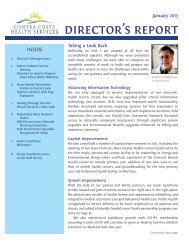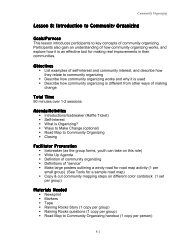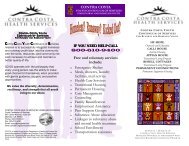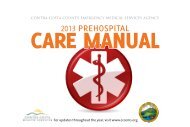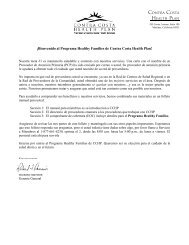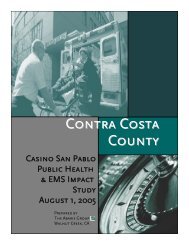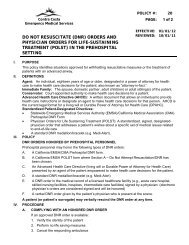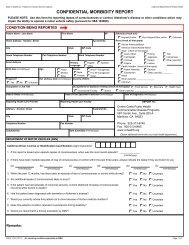EMS Policy Manual - Contra Costa Health Services
EMS Policy Manual - Contra Costa Health Services
EMS Policy Manual - Contra Costa Health Services
Create successful ePaper yourself
Turn your PDF publications into a flip-book with our unique Google optimized e-Paper software.
<strong>Contra</strong> <strong>Costa</strong><br />
Emergency Medical <strong>Services</strong><br />
9-1-1 ACTIVATION CRITERIA FOR NON-<br />
EMERGENCY TRANSPORT PROVIDERS<br />
POLICY #: 39<br />
PAGE: 1 of 1<br />
EFFECTIVE: 8/1/2012<br />
REVIEWED: 7/23/2012<br />
I. PURPOSE<br />
Define the criteria for upgrade to advanced life support (ALS) for non-emergency transport providers.<br />
II. DEFINITIONS<br />
Unstable: A patient who has a life- or limb-threatening condition requiring immediate and definitive<br />
care. An unstable patient may have respiratory distress, airway compromise, neurological changes<br />
from baseline, signs of actual or impending shock or may meet criteria for transport directly to a trauma<br />
center. (Refer to <strong>EMS</strong> <strong>Policy</strong> 20 for additional information regarding patients with valid DNR and\or<br />
POLST orders.)<br />
Non-emergency ambulance provider: An ambulance provider holding a valid <strong>Contra</strong> <strong>Costa</strong> nonemergency<br />
ambulance permit.<br />
9-1-1 ambulance provider: An ambulance provider holding a valid <strong>Contra</strong> <strong>Costa</strong> emergency<br />
ambulance permit and/or contracting with the County to provide advanced life support ambulance<br />
response to 9-1-1 requests.<br />
Code 3: Responding to a location and/or transporting to a receiving facility, using red lights and sirens.<br />
III. UNSTABLE PATIENTS<br />
A. A patient, determined to be unstable and/or needing “Code 3” transportation to a hospital, shall<br />
be transported by a 9-1-1 ambulance provider, whenever possible.<br />
B. Non-emergency ambulance providers may transport an unstable patient to the<br />
closest/appropriate facility, if they can do so safely and the time from arrival on scene to arrival<br />
at the hospital is less than ten (10) minutes. In all other cases, the non-emergency ambulance<br />
crew shall activate the 9-1-1 system and request an ALS response.<br />
C. Any non-emergency ambulance provider transporting a patient that becomes unstable during<br />
transport should divert to the closest/appropriate ED per the Patient Destination Determination<br />
<strong>Policy</strong> (<strong>Policy</strong> #9).<br />
Receiving facilities should receive notification as soon as possible of the need for diversion,<br />
patient status and the ETA to that facility.<br />
D. All transports by non-emergency ambulance providers of unstable patients, and/or transports<br />
requiring “Code 3” transportation are considered an unusual occurrence.<br />
For each such occurrence, an <strong>EMS</strong> Event Report must be completed and submitted to the<br />
<strong>EMS</strong> Agency within twenty four (24) hours of the call.<br />
IV. “ON-VIEWS”<br />
In the event that a non-emergency ambulance provider arrives on the scene of a collision, illness or<br />
injury by coincidence, the crew shall provide appropriate care and immediately activate the 9-1-1<br />
system.



